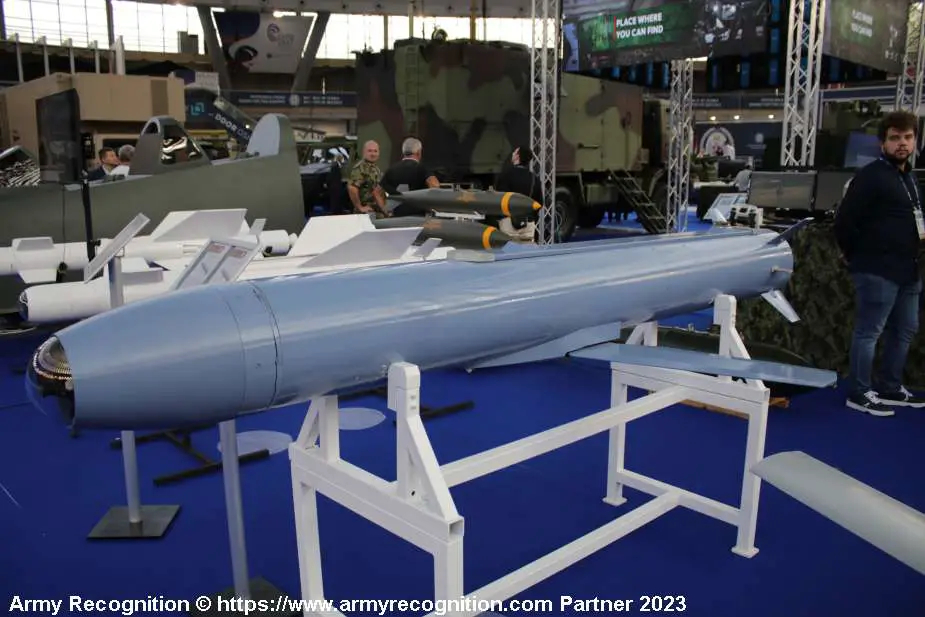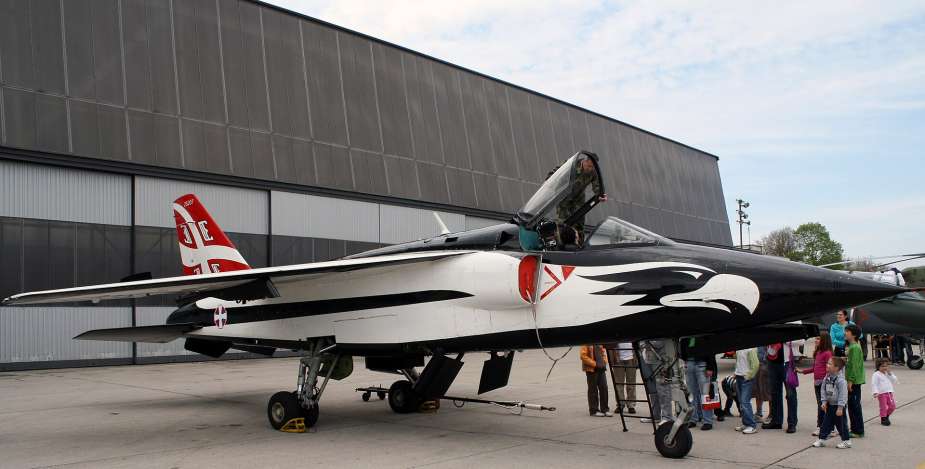Breaking news
Serbian defense debuts new air-to-surface guided missile Kosava 3.
The Military Technical Institute, affiliated with the Ministry of Defense of the Republic of Serbia, is presenting its latest air-to-ground guided missile, the Kosava 3, at the Partner 2023 Salon in Serbia. This advanced missile system is designed to destroy distant land targets, eliminating the need for targets to be directly visible at the time of launch. It should be noted that the Kosava 3 is compatible with the modernized version of the ORAO J22 aircraft.
Follow Army Recognition on Google News at this link

The Kosava 3 air-to-ground missile, developed by Serbia, can be compared to some types of Western and Russian missiles in terms of range and capabilities. (Picture source: Army Recognition)
Orao J-22 produced by Avioane Craiova in Romania, is a subsonic, twin-engine aircraft designed primarily for close air support, ground assault, and tactical reconnaissance missions. Available in both a single-seat attack configuration and a two-seat combat-ready version for advanced flight and weapons training, the aircraft was developed in the 1970s by Romania and Yugoslavia to reduce reliance on Soviet technology. While Romania manufactured the aircraft under the name IAR-93 Vultur, its Yugoslavian equivalent was produced by Soko and named the Soko J-22 Orao.
Serbian Air Force aircraft capable of launching air-to-ground missiles are mainly the MiG-29 and the Soko J-22 Orao. The MiG-29, a multirole aircraft, has 14 units in service, while the Soko J-22 Orao, the only one authorized to launch the KOSAVA 3, designed for close air support and ground attack missions, has 30 units in service. Both types of aircraft are holdovers from Soviet times and continue to play a key role in Serbia's air-to-ground strike capabilities.
The capabilities of the Kosava 3 surface-to-air missile presented at the show are particularly remarkable. The Kosava 3 has a maximum range of 120 km and is equipped with a high explosive (HE) warhead. One of the key features of this missile is its en-route guidance, which is achieved using inertial navigation systems (INS) coupled with GPS. During this phase, the operator has the possibility of selecting the target based on the images transmitted by the TV/IR guidance head of the missile via a data link. Once the target is locked on, the missile homing sequence is initiated.
It can operate at temperatures ranging from -30°C to +50°C. It has a length of 3 meters and a caliber of 300 mm. The total mass of the rocket is 430 kg, with the warhead alone weighing 320 kg. The warhead is of the explosive fragmentation type, and it is triggered by a composite impact fuse. The specific type of rocket engine propellant has not been disclosed.
In terms of applications, the Kosava 3 is versatile. Its primary function is to attack a wide range of ground targets. These can range from fortified structures and command posts to vehicles, warehouses, and technical support centers.
The Kosava 3 air-to-ground missile, developed by Serbia, can be compared to some types of Western and Russian missiles in terms of range and capabilities. On the Western side, the US AGM-84 Harpoon missile or AGM-158 JASSM (Joint Air-to-Surface Standoff Missile) could be analogs in terms of range and guidance capability. On the Russian side, the Kh-59 Ovod missile or the Kh-35 could be apt comparisons, as they are also designed for long-range air-to-ground missions and have advanced guidance systems.

Kosava 3 is compatible with the modernized version of the ORAO J22 aircraft. (Picture source: Wikimedia)


























